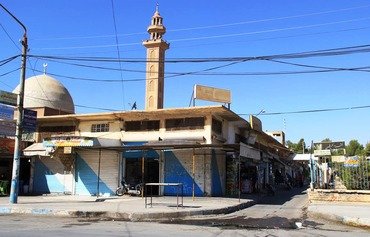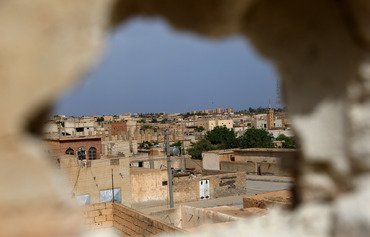The Syrian Democratic Forces (SDF) are pressing ahead with an offensive to liberate al-Tabqa from the "Islamic State of Iraq and Syria" (ISIS) despite encountering final pockets of resistance in the city's north side.
The Arab-Kurd alliance has captured more than 90% of al-Tabqa, but has not yet been able to fully clear the group's fighters out of the city or the adjacent dam, AFP reported Sunday (May 7th).
"The SDF has not been able to seize complete control of al-Tabqa because ISIS fighters are still present in the neighbourhoods of Wahdah and Hurriyah," said Syrian Observatory for Human Rights head Rami Abdel Rahman.
The two districts are in the city's north near al-Tabqa dam.
"The operation is going slowly because of the presence of civilians being used as human shields by ISIS," an SDF commander inside al-Tabqa told AFP on Sunday, saying his forces were trying to advance "carefully and accurately".
"Soon we will be able to announce the city fully cleared of ISIS," he added.
Sweep operations
SDF combat unit commander Abdel Fattah Nasruddin told Diyaruna that most of al-Tabqa’s districts were liberated on May 1st.
As SDF fighters swept the city, however, they discovered an unknown number of ISIS fighters hiding in civilian homes in the first, second and third quarters of al-Tabqa al-Jadida, Nasruddin said.
These districts are on the outskirts of the city near the south end of the dam.
"Extremely violent clashes ensued, particularly as the group’s elements are using civilians as human shields, hiding behind them during the battles," he said.
ISIS fighters first withdrew under pressure of heavy fire to the first and second quarters, fully vacating the third quarter, he said. The clashes continued until May 5th, when the group withdrew from the first and second quarters.
They then headed for al-Tabqa dam’s housing area, he said, adding that the fighting is currently confined to al-Musheirefah area in the vicinity of the dam, and the villages of Safsafa, Sahl Khashab and Ayed Kebir.
"Sweep operations are continuing, accompanied by international coalition airstrikes," he added.
Siege of al-Tabqa
"The progress of operations confirms the success and effectiveness of the plan put in place to impose a total siege on al-Tabqa," al-Raqa resident and SDF fighter Anas Mudhir told Diyaruna.
ISIS fighters were unable to escape and retreated to limited exposed areas, where they are hiding behind civilians to protect themselves, he said.
The group lost dozens of its fighters when the city was stormed, while others were captured by the SDF, Mudhir said.
"A number of them surrendered when they became certain that the city had fallen and they had no way of escaping," he said.
The SDF facilitated the exit of thousands of civilians from the city before and during the fighting by securing safe routes out of the area for them.
"However, it is clear that an unknown number of citizens were forcibly detained by the group to hide behind when the city comes close to falling," Mudhir said.
ISIS fighters also have taken a fortified position inside the dam's infrastructure, because they know the SDF and coalition will not damage the dam.
Removing explosives
SDF engineering teams entered al-Tabqa with the liberating forces and began dismantling the mines ISIS had planted on almost every street, said Mustafa Ceylan, of a team affiliated with the Kurdish People’s Protection Units (YPG).
The mines were planted "randomly, in a way that makes it impossible for the team to prepare a conceptual map to work from, with the aim of impeding the work of specialised teams", he told Diyaruna.
"Another obstacle is the fact that homes and surrounding areas are heavily booby-trapped," he said. "The sweep operations cannot be completed before they are removed, and it is impossible for the civilians to return with this massive quantity of them still in place."
Dozens of ISIS car bombs were seized during the operations and are being dismantled as well, Ceylan said.
"Some of them contained tonnes of high explosives so as to cause maximum damage to lives and property," he said, adding that some private homes were fully rigged with explosives as well.
Civilians flee the city
Al-Tabqa shopkeeper Hamad al-Nafeh told Diyaruna that he and dozens of other residents were able to flee the city before the liberating forces regained control.
This was thanks to a small group of SDF fighters "who risked their lives and slipped into the city to communicate with a number of trusted residents", he said.
The escape operation was arranged out of sight of ISIS fighters and their spies, who are scattered throughout the city, he said.
"The escape operation was carefully planned and executed along a specific route that was cleared of mines and secured by the liberating forces," al-Nafeh said.
The civilians were transported in SDF vehicles to a safe assembly point and were provided with food, water and blankets, he said, adding that medical care was provided to those in need.
After this, their documents were checked to verify their identities, he said, and they were transferred to a camp near Ain Issa. They are expected to be allowed to return after the fighting stops and the city is cleared of mines.

![Syrian Democratic Forces are now in control of more than 90% of al-Tabqa after expelling the 'Islamic State of Iraq and Syria' from most districts. [Photo courtesy of the Syrian Democratic Forces]](/cnmi_di/images/2017/05/10/7824-Syria-Tabqa-ISIS-600_384.jpg)





